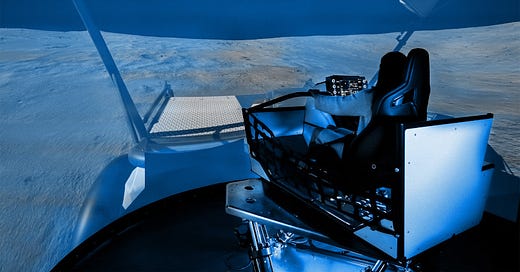Moon RACER Team Activates High-Fidelity Simulator
Advances LTV Development and Astronaut Training
The Moon RACER team, led by Intuitive Machines and backed by a world-class group of partners, has added a powerful new tool to its lunar mobility development ecosystem: a 6-degree-of-freedom (DOF) driver-in-the-loop simulator delivered by teammate AVL. The simulator is operational at Intuitive Machines’ Houston facility, just down the road from NASA’s Johnson Space Center.
“In this way, the team can test the actual vehicle we’re building before it leaves Earth.”
Brett Fischer, Intuitive Machines
At the core of this new capability is AVL’s Vehicle Simulation Model (VSM) software—a powerful virtual development platform used by engineering and professional motorsports teams worldwide. Now, it’s accelerating lunar mobility. The Moon RACER team is actively using VSM to digitally integrate maturing Lunar Terrain Vehicle (LTV) subsystems, including motors, batteries, steering actuators, suspension, tires, controls, and powertrain, into a single high-fidelity driving model that mimics lunar gravity and terrain. As system development matures, simulation data is replaced by physical test data and the simulator enables engineers to track the LTV development to targets without physical and costly prototypes. The Moon Racer team believes understanding system integration and performance compared to target achievement assists in the development of the LTV. Astronauts can also drive and interact with the vehicle in the same way they would in their normal operation of the vehicle and provide critical feedback required to increase mission success.
“In this way, the team can test the actual vehicle we’re building before it leaves Earth,” said Intuitive Machines LTV Lead Brett Fischer. “The team has effectively closed the loop between design, test, and astronaut feedback. We believe this early capability will assist in LTV readiness and help minimize risk.”
For astronauts, the simulator goes beyond vehicle familiarization. Leveraging data from NASA and Intuitive Machines Phoenix Office for lunar reconnaissance, is uses terrain modeled after the lunar south pole to recreate specific mission routes, shadow conditions, and sun angles in a virtual lunar environment. It even simulates one-sixth Earth gravity by modifying driving feedback to reflect how the LTV would behave on the Moon, allowing astronauts to evaluate factors like braking behavior, suspension loading, powertrain performance, and driver fatigue. The Moon RACER team engineers intend to use the feedback to fine-tune the vehicle’s design well before launch.
NASA’s LTV Services contract award encompasses the Lunar Terrain Vehicle itself, the proposed launch vehicle, communications architecture, and the lunar lander responsible for delivering it to the Moon’s surface. As part of this award, Intuitive Machines has advanced its cargo-class lunar lander design and integrated in-house data transmission solutions, leveraging its Near Space Network Services contract to support both Direct-to-Earth and lunar data relay satellite communications.
The LTV Services contract award by NASA encompasses not just the LTV itself, but also its proposed launch vehicle, communications architecture, and the lunar lander that delivers it to the Moon’s surface. As part of the NASA award, Intuitive Machines has matured its cargo-class lunar lander design and provided in-house data transmission solutions based on its Near Space Network Services contract for Direct-to-Earth and lunar data relay satellite constellation.
As previously announced, NASA’s LTV Services feasibility assessment contract remains a competitive process. The Intuitive Machines-led Moon RACER team is one of only three vendors vying for the next phase—the delivery and demonstration mission, which NASA has indicated they plan to award by the end of 2025.





